John Hurrell – 9 January, 2024
Another is Hut II, 2013, a freestanding sculpture of neon tubes that delineate a simple 3D archetype of a peaked roof house (not standing on a reflective glass sheet like with the larger version included in Culbert's 2013 Venice Biennale presentation). Five framed holograms from 1982 are also presented on one wall, as is a suite of ten b/w photographs on another of an open shuttered window—taken from outside and inside 'la Croagnes maison'—and featuring differing degrees of natural illumination.
Titirangi
Bill Culbert
Blue Cloud, Green Waterfall
Curated by James Gatt
9 December 2023 - 11 February 2024
Within this unusual look at the career of the Bill Culbert (1935 - 2019)—a show organised and selected by Australian James Gatt, the recently appointed curator at Te Uru—the nine types of artifact chosen from the Culbert archives (held by Fox Jensen McCrory Gallery) allow us in the large ground floor gallery to ponder some of Culbert’s underpinning thought patterns that usually focussed on perception. Culbert (a New Zealander) lived in both France and England. In 1997 he had a touring survey in NZ organised by City Gallery.
One element chosen by Gatt is a very long horizontal vitrine of 37 assorted notebooks and drawings (1963-2009) which, of course, we can’t flip through and scrutinise. The single page notebooks, jotted down sheets of poetry or quotations of theory, and double page spreads of planning sketches however are carefully chosen: it is a fascinating but brief look at Culbert’s many research preoccupations.
Another is Hut II, 2013, a freestanding sculpture of fluorescent tubes that delineate a simple 3D archetype of a peaked roof house (not standing on a reflective glass sheet like with the larger version included in Culbert’s 2013 Venice Biennale presentation). Five framed holograms from 1982 are also presented on one wall, as is a suite of ten b/w photographs on another of an open shuttered window—taken from outside and inside la Croagnes maison—and featuring differing degrees of natural illumination.
There are also two large coloured photographs, Long View (Croagnes, France), 1992, that pun on binoculars, emotional distancing, hollow bricks, and methods of photographic construction; and Flat White Light, 2000, two unusual illuminated spiral ‘drawings’ on another wall using stapled lengths of cable and centrally-positioned glowing bulbs—and shown at Sue Crockford’s in 2007. Apart from the electrical bulb light, they also catch the traversing natural light coming through the staircase window and comment on the wall as a huge ‘picture plane’. Plus finally, there is Untitled (Glass Engravings), c. 1990, a set of twenty engravings (with glowing white lines) cut into the glass. They show a symmetrical sequence of filling and emptying wine in a goblet. Wine here is seen as a metaphor for light that we see trapped in the etched grooves.
We also discover Nightlight, 1981, a painted-over (matte) landscape photograph of the French village of Croagnes where Culbert lived, with odd perspectivally-shaped sheets of reflective glass attached to the picture plane, and a glowing reading lamp on top spilling light onto the image. To the left along the wall we find nearby, Light, Croagnes, 1980, a photograph of reflecting glass sheets positioned on a floor to mimic the pane shapes of the very same window which admitted the reflected light in the first place.
As you’d expect with Culbert, a personal encounter with the physical objects and the light surrounding/affecting them in the gallery space is crucial for any grasping of their raison d’être. Looking at such photos online doesn’t ‘cut’ it. And there is a calculated paradox that the wall labels are deliberately printed on shiny aluminium sheets (a curatorial intervention), forcing the initially thwarted viewer to move around and stand where the interfering reflected light allows them to read. That many of the adjacent works in rows are framed in highly reflective glass is unfortunate.
I have a hunch that two works here were partially inspired by a couple of Roy Lichtenstein works, particularly Culbert’s linear fluorescent tubed ‘hut’, and the painted photograph with an attached reading lamp and glass sheets. Lichtenstein had earlier created a very large flat-planar freestanding ‘comic-strip’ House, and a much smaller wall-based screened Seascape #19 with a working horizontal reading lamp on top.
Culbert’s strangely coloured, five green and dark red holograms were a revelation to me. The images subtly move as you walk past, and are ‘double-exposed’ and transparent. One (Window 84490, 1982) is a landscape seen through a tilted window; another (Eclipse, 1982) presents sunlight flaring on edge of a circular rim (of a wineglass?); another still (Untitled, 1982) is a tilted antique liqueur glass containing chartreuse; a fourth, Untitled (Glass and Bulb), 1982, shows a tilted wine glass with a frosted lightbulb on its side; while a fifth, Crysle and Carpark 6, 1982, depicts a pair of sideways-positioned salt and pepper shakers with a vertical jar of Spanish olives, and some block-lettered street signage in the background.
There is a lot of unusual work here for any keen Culbert enthusiast to investigate, and to excite those new to his practice. While carefully negotiating the many interrupting reflective surfaces can be an irritation—especially for viewing the holograms—the rewards for perseverance I hope are obvious.
John Hurrell
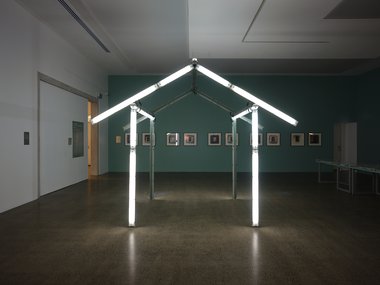
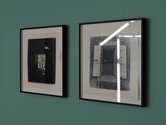
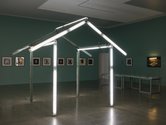
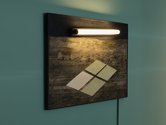
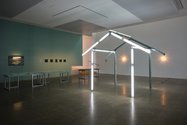
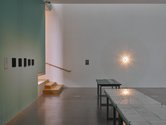
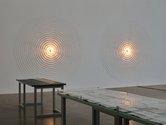
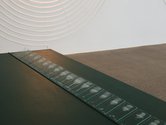
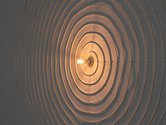
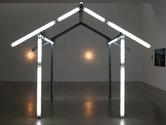
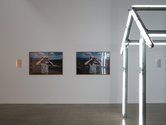
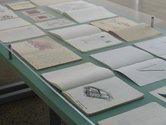
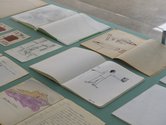

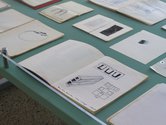
 Advertising in this column
Advertising in this column Two Rooms presents a program of residencies and projects
Two Rooms presents a program of residencies and projects



This Discussion has 0 comments.
Comment
Participate
Register to Participate.
Sign in
Sign in to an existing account.